Harbour Monthly Commentary: In a more normal world?
Throughout this equity rally we have been asked how much of the sharp rise in equity markets is just about a return to “normal”?
Monday, April 8th 2013, 6:00AM
by Harbour Asset Management
In the last month 8 months we have highlighted that:
• Central banks are very focussed on getting an acceleration in economic growth – in contrast to the normal central bank focus on inflation and price control. Central bank’s are not behaving in a normal world, in fact a return to normal – the so called exit strategy – may pose risks to markets
• Interest rates are going to stay low for longer – this is not a normal world
• On the other hand we have seen a pronounced fall in both implied volatilities and economic uncertainty, which in part reflects a return to normal, and as a result
• The equity risk premium is also normalising, and for now equity–bond yield correlations are positive. While this has been a feature of the recent past – if economic growth does improve significantly we would expect correlations to become negative.
So the answer is that part of the equity rally is definitely about a move to markets focussing more on earnings and dividends, but in addition markets need to factor in the influence of much lower than normal interest rates. We also need to consider how long equity market returns and bond yields will remain positively correlated (that is, bond yields rise; equities rise and vice versa).
While markets have started to focus on corporate profits, in reality the equity market rally has not been about actual economic growth or earnings and dividend growth. In fact there have been small downward revisions to economic growth in all regions except Japan and China in recent months. Forward earnings growth signals from around the world have been flat at best, with corporates making more gains in margins through cost control, than leaps forward in headline sales growth. Perhaps this is the new norm.
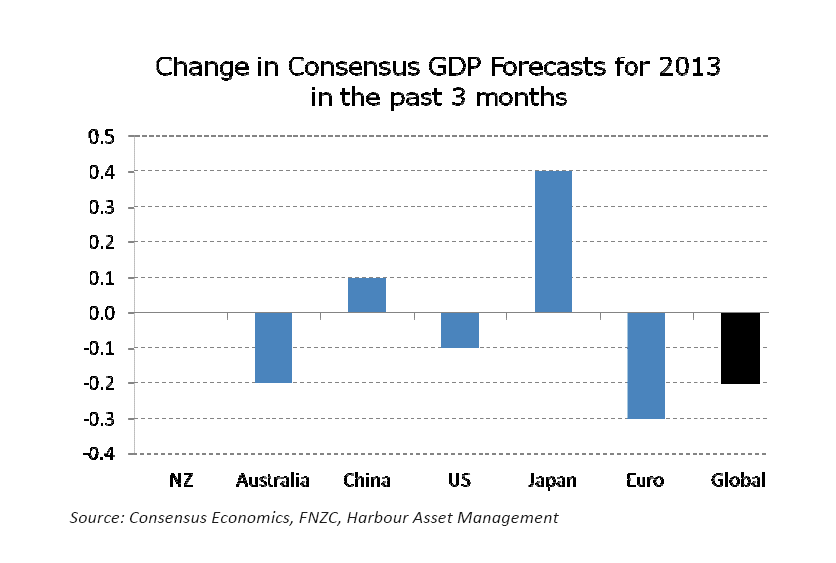
Volatility remains low
The weight of money in markets is significant. The March quarterly flow into US based equity funds was a net $52bn, the highest since 2004. Globally over $65bn was added to equity funds in the quarter. The key flows were into yield and income products. Importantly, we have not seen a rotation out of bonds (yet). So far the flow into equities is coming from cash. The global rally in equities is continuing for now because funds have money to invest. Corporates are lifting dividend payments and balance sheets remain strong.
If investors start to switch flows from bonds to equities, this rally has significant legs yet.
It is also possible for the rally to continue despite the emergence of slightly slower economic growth, on-going tensions in peripheral Europe, tension in the Korean peninsula, and evidence that the US fiscal tightening is impacting US business confidence. However, the rally now is not that convincing. Breadth is narrowing. Commodity prices have fallen back, bond yields have fallen again, European bank share prices have fallen and high beta emerging market equities are weak. Perhaps the only significant feature is that volatility remains low.
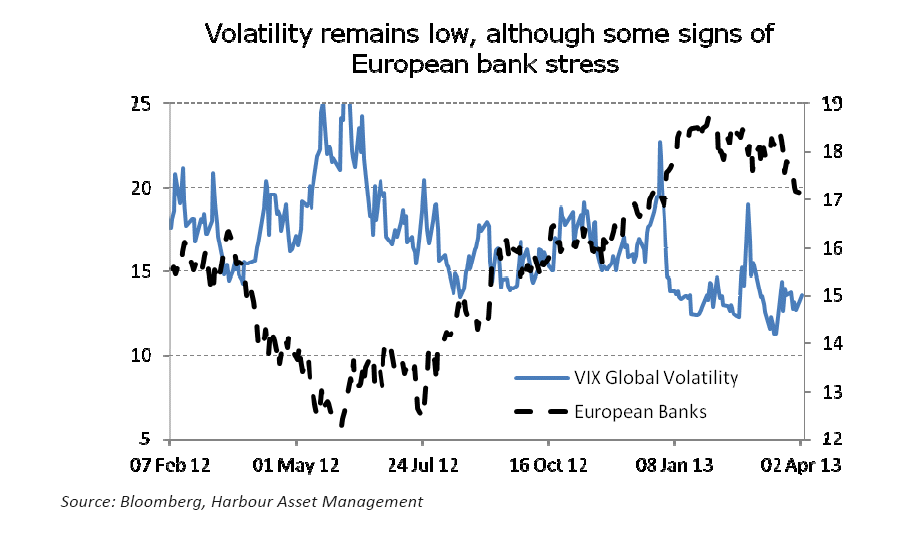
Bond and Equity Correlations Remain Positive – This may change
Another key feature of markets is the recent very high positive correlation of changes in Australian bond yields with Australian equity returns. This is in contrast with the prior 4 decades of data.
A key question that investors worry about is what happens when bond yields rise? A recent positive correlation between bond yields and equity markets suggests that equity markets might continue to rise if bond yields rise. Another interpretation considers that equities could continue to rally even if bonds are rising because growth is improving. If bond yields start to gradually rise because growth is improving it is possible that equities continue to rally.
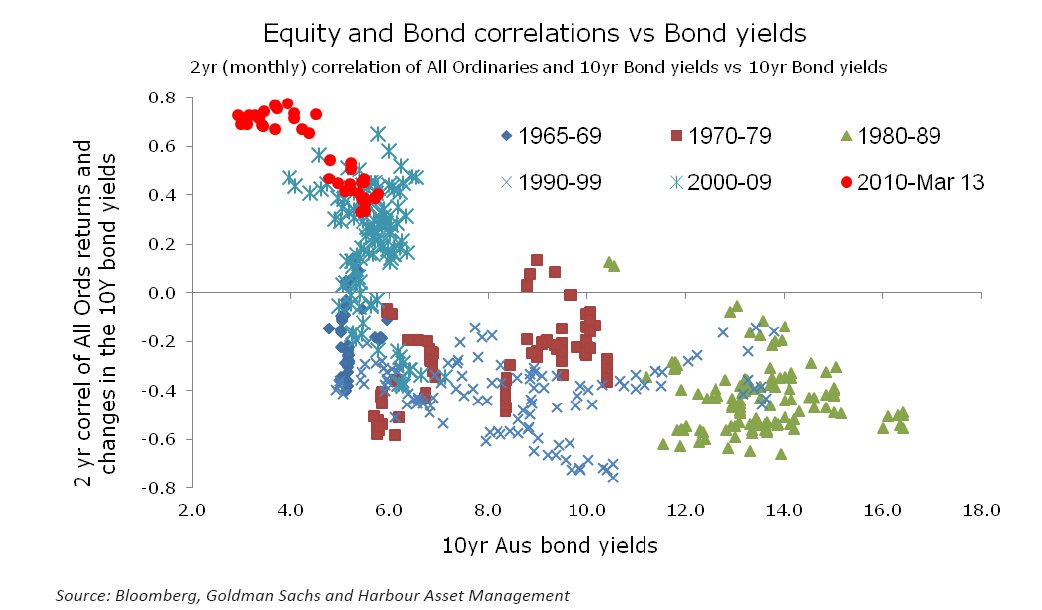
Looking again at Australian data we see that over the last decade there has been a positive correlation between changes in business confidence, changes in the 10 year bond yield and the equity market. We know that over the long term (1965-1999) equity-bond correlations were negative. The deciding factor is likely to be growth. For the Australian market to move higher it is likely that we will need to see a lift in business confidence, that parallels the recent lift in consumer confidence.
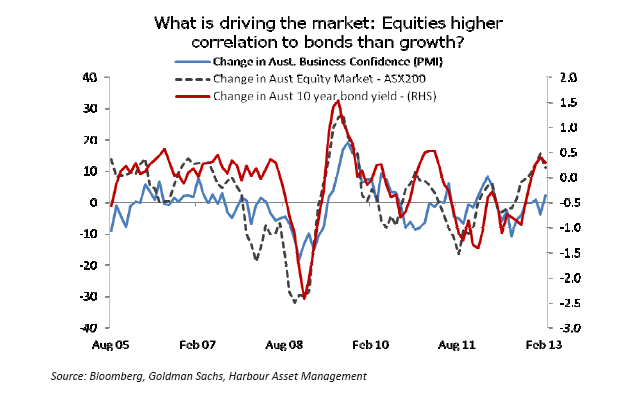
And at the moment an improvement in Australian business confidence might be tough as it seems that the world (ex-Japan) has lost some momentum.
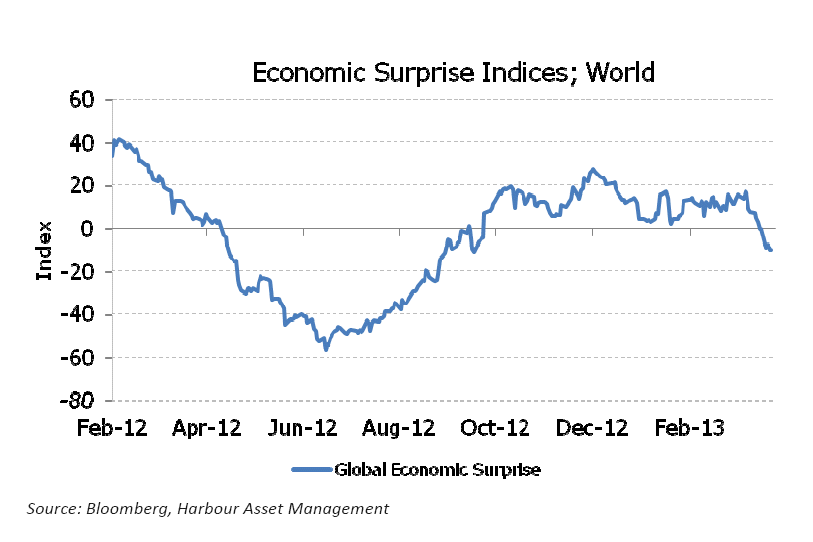
Therefore, for Australia and New Zealand the real conundrum is China where if anything economic forecasts are up a touch, and actual data has been mildly stronger. It seems that markets are getting their cue from policy statements in China that suggest a potential for tightening policy (particularly in the housing sector). As a result iron ore prices have fallen, and with that shares in the large mining companies have come back. In contrast for New Zealand, our commodity prices have risen – but that reflects short term concerns over supply.
It is our view that commodity markets have over-reacted to both the pull back in global growth expectations and the New Zealand drought. Moreover, we are watchful as to Chinese data outcomes – for now there is no confirmation that the economy is weakening.
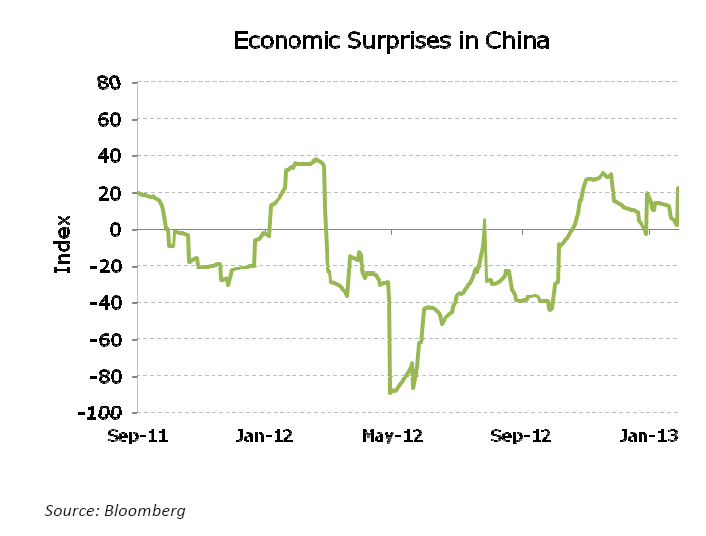
In New Zealand, investors will focus significantly on Might River Power
In New Zealand, there has been little change over the last month in the outlook. The equity market has been driven higher by investment flows rather than news. After a strong March many shares have now moved higher than consensus target prices formed by share broking analysts.
A major issue in April will be setting market pricing of Mighty River Power (MRP). Already we know there is significant retail investor interest in MRP. One way of thinking about what price may be appropriate for MRP is to consider the cash yield a marginal investor requires to make the stock appear attractive in current portfolios. Note we are not providing any financial advice in this analysis and everyone should consult their own investment adviser.
A diversified portfolio of 50 Australian and New Zealand securities selected for their stability in earnings, yield and earnings growth potential currently has a cash yield of about 5.4%. The same portfolio has prospective earnings growth of over 6% pa over the next two years with relatively low forecast dispersion in earnings forecasts. To us these are the benchmarks which a yield focussed investor may use to judge the merits of including MRP in their portfolio. Investors may also be more focussed in comparing MRP to a smaller selection of “similar” stocks, such as of course Contact Energy or other large New Zealand listed companies.
There are many other reasons for holding MRP shares – globally “green” funds have limited mandates and may invest for non-yield reasons, retail investors may have a home bias and be more interested in the prospective gross yield (including imputation credits). In addition, many investors use alternative valuation approaches and may find MRP attractive on different measures. We are assessing MRP ourselves from a number of angles, but at the end of the day we think that yield will be an important factor in the current environment.
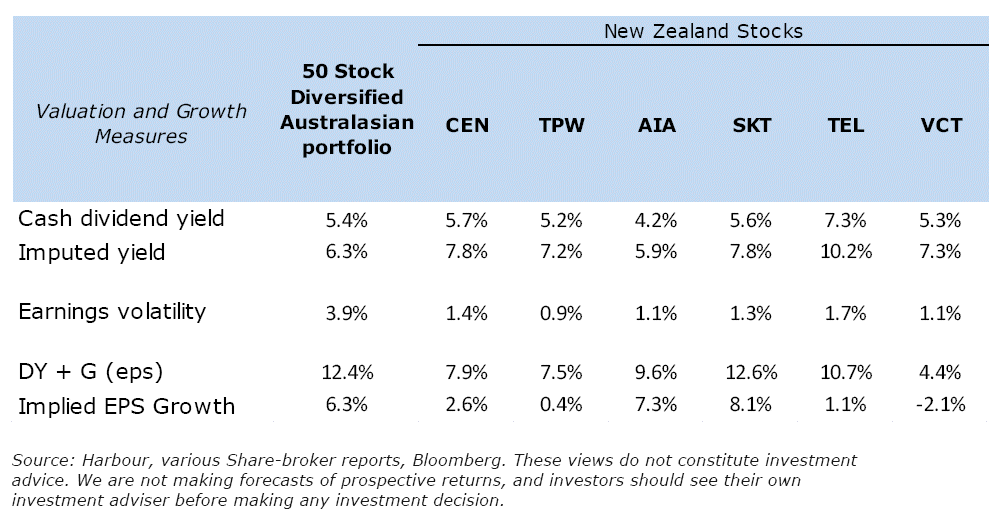
Outlook
With momentum in global growth indicators stalling, the lead from global equity markets may weaken. However, interest rates are now more likely to stay low and the pattern of investor interest in sound companies in both Australia and New Zealand is likely to continue. Markets brushed off Cyprus events, and now attention turns to the US earnings round and further evidence of economic momentum.
Our central view is that equities are still in a favourable part of the business cycle. There is strong evidence that flows into equities are continuing. Merger and acquisition activity is picking up and valuations relative to cash and bonds suggest further upside. While returns may stutter in the short term, it could still be the case that we are only part way through a longer positive cycle for equities if earnings and dividend growth continue to deliver.
The big local issue on the horizon is participation in the Mighty River Power IPO. One way to think about this is to discover a “break-even” cash yield that investors are likely to demand, although there are many other factors to take into account and each investor should consult their own investment adviser and consider carefully the role MRP may take in a more diversified portfolio.
With the New Zealand market out-performing Australia in March, we think that perhaps some of the best return opportunities will come from monitoring Australian companies in the period ahead. We also favour a longer term focus on key sectoral growth trends associated with demographics, Asian urbanisation, the adoption of technology, the focus on yield and the ability of companies to improve margins through productivity improvements.
Andrew Bascand
Managing Director
Harbour Asset Management Limited
Craig Stent
Director & Research Analyst
Harbour Asset Management
Important disclaimer information
| « Tyndall Monthly Commentary: Does Cyprus Really Matter? | Hamish Douglass Unplugged - Latest Video from Adviser Briefing - August 2012 » |
Special Offers
Comments from our readers
No comments yet
Sign In to add your comment
| Printable version | Email to a friend |









